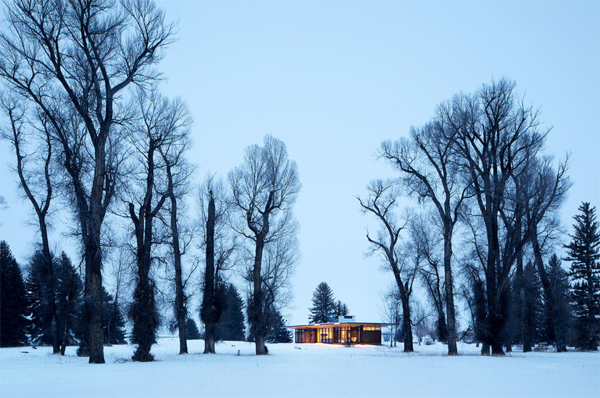Let’s take a moment out of the hustle and bustle of summer, and if some of you are happier with winter then take a look at this Queen’s Lane Pavilion project by Carney Logan Burke Architects. This is a guest house that is inspired by nature, contemporary overhauled and are in the most remote sites in Jackson, Wyoming. This guest house is not specifically designed for winter, but wait until you see the snow around, when the river begins to freeze with a stunning expanse of white snow, who is not blown away? This is a vast undertaking with projects in a wildlife-rich river ecosystem.
Queen’s Lane Pavilion is the perfect escape for those of you who want peace and closer to nature. The open interior concept, outdoor dining area and unique walls that show off the surrounding views are a bit of what is offered by this extraordinary guest house. Architects in collaboration with the family that owns the house to give a new look and feel refreshing. More precisely, architects and homeowners want to renovate traditional to modern home styles. Follow along and see what the architect says about this guest house!
From the architects,
“CLB has collaborated with one family on a 180-acre Jackson Hole property over a period of twenty-plus years. The breadth of work – five projects in a wildlife-rich riverine ecosystem – depicts the evolution of one couple’s aesthetic: it has carved a steady arc from traditional to modern.
The first building, a Parkitecture-influenced log, stone and timber lodge, anchors the compound. This was followed by an office/shop, designed in a transitional style, and a wine silo. With its interior spiral staircase and rooftop viewing platform, the silo celebrates rustic modernism through a classic agrarian form clad in oxidized steel plates and offers a dramatic sculptural expression. An iconic covered bridge came next, then the natural end point: a modernist flat-roofed glass pavilion. Conceived as a retreat for the owners, its streamlined, nature-oriented outlook makes the most of its location between two spring creeks and allows the owners, now empty-nesters, to experience their property in a whole new light.”
“This two-bedroom guesthouse was built on the site of an older structure that predated the current owners. Because it resides within today’s minimum setback requirements, the project necessitated a two-year planning process with Teton County and conscientious consideration of wildlife, waterways and trees. Architect Eric Logan, who designed all five structures, followed the exact footprint of the original building. An L-shape, the short section houses the garage, while the longer section encompasses the bedrooms and a graciously scaled open plan living/kitchen/dining space. There, an ethereal airiness is achieved from window walls on the longer north and south sides balanced by masses of white at either end of the long room. The fireplace anchors one end, the kitchen the other; with openings on either side of each, both masses float between the walls. Beyond those masses lie the bedrooms, each glassed-in area designed as its own private nature experience. White oak floors and ceilings warm and ground the entire home.
With the addition of deep protective overhangs, minimalist patios that merge into the landscape and a pierced steel curtain, the house becomes an art piece. These metal sheets, cut to a pattern derived from a photo of the surrounding cottonwood grove, modulate the views and cast interesting shadows inside the home. From the outside, they soften the glass expanses, offer aesthetic interest, and give the building a patina that ties it to the wine silo while lending it a natural appearance in the landscape.”
“The structure relates to its neighbors, yet inhabits its own micro-ecosystem on the property; the owners’ two decades of habitat enhancement projects has created a thriving fishery and miniature wildlife refuge frequented by elk, eagles, moose, deer and coyotes. With necessities such as laundry located in the lodge, the home is free to express its essence. The influence of the water, the protection of the cottonwoods, and the simplicity of the building (from a distance, it is perceived as one line in the landscape) align in a special moment on the property. This serene glass pavilion – modernist wildlife viewing blind during the day, luminous lantern amidst the trees at night, comfortable retreat at all hours – is a fitting tribute to that moment.”















Reply